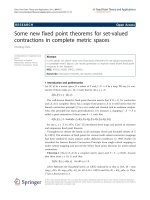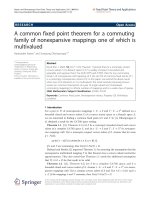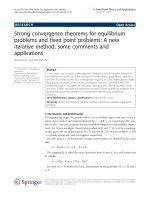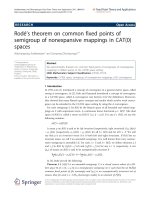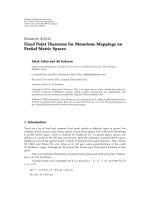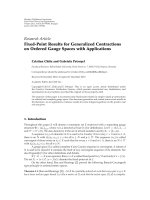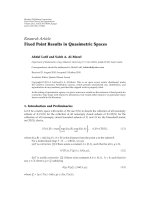Báo cáo hóa học: " DUAN’S FIXED POINT THEOREM: PROOF AND GENERALIZATION" potx
Bạn đang xem bản rút gọn của tài liệu. Xem và tải ngay bản đầy đủ của tài liệu tại đây (532.54 KB, 10 trang )
DUAN’S FIXED POINT THEOREM: PROOF AND
GENERALIZATION
MARTIN ARKOWITZ
Received 25 July 2004; Revised 6 January 2005; Accepted 21 July 2005
Let X be an H-space of the homotopy type of a connected, finite CW-complex, f : X
→ X
any map and p
k
: X → X the kth power map. Duan proved that p
k
f : X → X has a fixed
point if k
≥ 2. We give a new, short and elementary proof of this. We then use rational
homotopy to generalize to spaces X whose rational cohomology is the tensor product of
an exterior algebra on odd dimensional generators with the tensor product of truncated
polynomial algebras on even dimensional generators. The role of the power map is played
by a θ-structure μ
θ
: X → X as defined by Hemmi-Morisugi-Ooshima. The conclusion is
that μ
θ
f and fμ
θ
each has a fixed point.
Copyright © 2006 Martin Arkowitz. This is an open access article distributed under the
Creative Commons Attribution License, which permits unrestricted use, distribution,
and reproduction in any medium, provided the original work is properly cited.
1. Introduction
Let G be a topological group and f : G
→ G a map (i.e., a continuous function). Let
p
k
: G → G be the kth power map defined by p
k
(x) = x
k
. Recall that a fixed point of f
is an element x
0
∈ G such that f (x
0
) = x
0
. In 1993 Duan Haibo proved the following
interesting fixed point theorem.
Theorem 1.1 [1]. If G is a compact, connected topological group and f : G
→ G is a map,
then for any k
≥ 2, the map p
k
f : G → G has a fixed point.
This theorem was proved more generally for homotopy-associative H-spaces having
the homotopy type of a finite, connected CW-complex (Theorem 2.2). In 1996, Lupton
and Oprea [2] gave a new proof of Duan’s theorem using rational homotopy theory. In
1997, Hemmi-Morisugi-Ooshima [3] extended Duan’s theorem to spaces more general
than homotopy-associative H-spaces. In all of the above results, the existence of a fixed
point of a map was obtained by showing the Lefschetz number of the map is non-zero.
The purpose of this paper is two-fold. First, we give a new, short proof of Duan’s
theorem. The proof is elementary in that the only non-trivial result required is the
Hindawi Publishing Corporation
Fixed Point Theory and Applications
Volume 2006, Article ID 17563, Pages 1–10
DOI 10.1155/FPTA/2006/17563
2 Duan’s fixed point theorem: proof and generalization
Hopf-Leray-Samelson theorem on the rational cohomology of a homotopy-associative
H-space. Secondly, we use rational methods, in particular, a result of Halperin [4], and
ideas from [3] to generalize Duan’s theorem.
2. Duan’s theorem
We begin by briefly discussing the Lefschetz number and H-spaces. All spaces will be
assumed to have the homotopy type of a finite, connected CW-complex (though this as-
sumption can be weakened). The cohomology of a space with coefficients in the additive
group of rationals will be written H
∗
(X) ={H
n
(X)}, so that cohomology will always
be taken with rational coefficients. A map f : X
→ X induces a linear transformation
f
∗n
: H
n
(X) → H
n
(X). The Lefschetz number is defined by
L( f )
=
N
n=0
(−1)
n
Tr
f
∗n
, (2.1)
where H
i
(X) = 0, for i>N, and Tr denotes the trace. Lefschetz’s famous fixed point the-
orem asserts that if L( f )
= 0, then f has a fixed point [5].
Next we state some basic facts about H-spaces. An H-space consists of a space X and
amapm : X
× X → X (called the multiplication) such that m restricted to each factor is
homotopic to the identity map id. For an H-space X,thepowermapp
k
: X → X, k ≥ 1, is
inductively defined as follows: p
1
= id, and p
k
is the composition
X
Δ
X × X
p
k−1
×id
X × X
m
X,
(2.2)
where Δ is the diagonal map. The multiplication m induces a homomorphism m
∗
:
H
∗
(X) → H
∗
(X × X) ≈ H
∗
(X) ⊗ H
∗
(X). An element x ∈ H
n
(X)iscalledprimitive if
m
∗
(x) = x ⊗ 1+1⊗ x.Ifx ∈ H
n
(X) is primitive, then it follows immediately from the
definitions that
p
∗
k
(x) = kx. (2.3)
The H-space X is said to be homotopy-associative if the maps m(m
× id), m(id × m):
X
× X × X → X are homotopic. The Hopf-Leray-Samelson theorem ([6, page 268] and
[7, Theorem 7.20]) asserts that if X is a homotopy-associative H-space, then
H
∗
(X) = Λ
x
1
,x
2
, , x
r
, (2.4)
an exterior algebra on odd degree generators x
1
,x
2
, , x
r
which are primitive.
With these generalities out of the way, we state an obvious lemma and proceed with
Duan’s theorem and its proof.
Martin Arkowitz 3
Lemma 2.1. If A is an n
× n matrix of rationals and B is a diagonal n × n matrix of rationals,
A
=
⎛
⎜
⎜
⎜
⎜
⎝
a
11
a
12
a
1n
a
21
a
22
a
2n
.
.
.
.
.
.
.
.
.
.
.
.
a
n1
a
n2
a
nn
⎞
⎟
⎟
⎟
⎟
⎠
, B =
⎛
⎜
⎜
⎜
⎜
⎝
b
1
0 0
0 b
2
0
.
.
.
.
.
.
.
.
.
.
.
.
00 b
n
⎞
⎟
⎟
⎟
⎟
⎠
, (2.5)
then Tr(AB)
= a
11
b
1
+ a
22
b
2
+ ···+ a
nn
b
n
= Tr( BA).
We write the diagonal matrix B as diag(b
1
,b
2
, , b
n
).
Theorem 2.2 [1]. If X is a homotopy-associative H-space, f : X
→ X any map and p
k
:
X
→ X the kth power map, k ≥ 2, then p
k
f : X → X has a fixed point.
Proof. We show that L(p
k
f ) = 0. For this we consider the trace of (p
k
f )
∗n
= f
∗n
p
∗n
k
H
n
(X)
p
∗n
k
H
n
(X)
f
∗n
H
n
(X).
(2.6)
By the theorem of Hopf-Leray-Samelson,
H
∗
(X) = Λ
x
1
,x
2
, , x
r
, (2.7)
where the x
i
are primitive elements of odd degree |x
i
|=m
i
.Ifn ≥ 1 then a basis of H
n
(X)
consists of elements
y
i
1
i
2
···i
l
= x
i
1
x
i
2
···x
i
l
, (2.8)
where l
≥ 1, 1 ≤ i
1
<i
2
< ···<i
l
≤ r and m
i
1
+ m
i
2
+ ···+ m
i
l
= n. We examine the matrix
of p
∗n
k
and f
∗n
with respect to this basis. Since p
∗
k
(x
i
) = kx
i
,
p
∗n
k
y
i
1
i
2
···i
l
=
k
l
y
i
1
i
2
···i
l
. (2.9)
Now suppose that there are b
(n)
1
basis elements in H
n
(X) of length one (i.e., those of the
form y
i
), b
(n)
2
basis elements in H
n
(X) of length two (i.e., those of the form y
i
1
i
2
, i
1
<i
2
),
etc., where b
(n)
i
≥ 0. Then the matrix B of p
∗n
k
is diagonal,
B
= diag
k, , k
b
(n)
1
,k
2
, , k
2
b
(n)
2
,
. (2.10)
Next we consider the matrix A of f
∗n
with respect to this basis. Now f
∗n
is obtained
by taking the homomorphism on integral n-dimensional cohomology induced by f and
tensoring it with the rationals. Thus A is a matrix of integers. Let e
(n)
1
be the sum of the
first b
(n)
1
diagonal entries of A, e
(n)
2
the sum of the next b
(n)
2
diagonal entries, etc. Then by
Lemma 2.1,
Tr
p
k
f
∗n
=
Tr( AB) = ke
(n)
1
+ k
2
e
(n)
2
+ ···+ k
r
e
(n)
r
. (2.11)
4 Duan’s fixed point theorem: proof and generalization
Thus Tr((p
k
f )
∗n
) ≡ 0(mod k)forn ≥ 1, and so L(p
k
f ) ≡ 1(mod k). Since k ≥ 2, we have
L(p
k
f ) = 0. This completes the proof.
Remark 2.3. There are some simple extensions of Theorem 2.2:
(1) If the H-space X has a homotopy inverse, one can define p
k
for all integers k.
Theorem 2.2 then holds for all
|k|≥2.
(2) Theorem 2.2 holds for the map fp
k
: X → X since it is well known that L( fp
k
) =
L(p
k
f ).
(3) Let k be an integer such that
|k|≥2. Suppose that X is a homotopy-associative H-
space and there is a map μ : X
→ X such that μ
∗
(x
i
) = a
i
x
i
,wherea
i
≡ 0(modk),
for i
= 1,2, ,r. Then the previous proof shows that if f : X → X is any map, then
μf and fμeach has a fixed point. We will return to this in Section 4.
We note the following immediate consequence of Duan’s theorem which appears in
[5, Theorem 1, page 49].
Corollary 2.4. Let G be a compact, connected topological group, a
∈ G and k ≥ 2. Then
there exists x
0
∈ G such that x
k
0
= a.
Proof. Let L
a
: G → G be left multiplication by a. By Duan’s theorem, L
a
−1
p
k+1
hasafixed
point x
0
.
3. Fixed points and eigenvalues
In this section we consider spaces with restricted cohomology and state a result on the
Lefschetznumberofselfmapsofsuchspaces.Thisresult,Theorem 3.1, which may be of
some interest in itself, will be used to generalize Duan’s theorem in Section 4.
Let Y be a space and consider the vector space I
∗
(H
∗
(Y)) ={I
n
(H
∗
(Y))} of indecom-
posables of H
∗
(Y)definedby
I
∗
H
∗
(Y)
=
H
+
(Y)
H
+
(Y) · H
+
(Y)
, (3.1)
where H
+
denotes positive-dimensional cohomology. A map f : Y → Y
induces f
∗
:
H
∗
(Y
) → H
∗
(Y) and this induces a linear transformation I
∗
( f
∗
):I
∗
(H
∗
(Y
)) →
I
∗
(H
∗
(Y)).
For the rest of this section we consider spaces X whose cohomology has the following
form
H
∗
(X) = Λ
x
1
,x
2
, , x
r
⊗
P
y
1
, y
2
, , y
s
/
y
n
1
1
, y
n
2
2
, , y
n
s
s
, (3.2)
where Λ(x
1
,x
2
, , x
r
) is an exterior algebra on odd dimensional generators x
1
,x
2
, , x
r
,
P(y
1
, y
2
, , y
s
) is a polynomial algebra on even dimensional generators y
1
, y
2
, , y
s
and
y
n
1
1
, y
n
2
2
, , y
n
s
s
is the ideal generated by the powers y
n
1
1
, y
n
2
2
, , y
n
s
s
. In short, H
∗
(X)isa
tensor product of monogenic algebras.
We will always assume for a space X which satisfies (3.2) that 1 <n
1
<n
2
< ···<n
s
.
We give examples of such spaces in Examples 3.3(1).
Martin Arkowitz 5
Now let X be a space satisfying (3.2)and f : X
→ X a map. The vector space of inde-
composables I
∗
(H
∗
(X)) can be split into its odd and even degree parts
I
∗
H
∗
(X)
=
V ⊕ W, (3.3)
where V
=
iodd
I
i
(H
∗
(X)) and W =
ieven
I
i
(H
∗
(X)). Then I
∗
( f
∗
):I
∗
(H
∗
(X)) →
I
∗
(H
∗
(X)) induces linear transformations
f
V
: V −→ V, f
W
: W −→ W. (3.4)
The following theorem will be proved in Section 5.
Theorem 3.1. Let X beaspacesatisfying(3.2)and f : X
→ X a map. Suppose that −1 is
not an eigenvalue of f
W
. Then
L( f )
= 0 ⇐⇒ f
V
hasnoeigenvalueequalto1. (3.5)
We make some remarks on the theorem.
Remarks 3.2. (1) T he matrices of the linear transformations f
V
and f
W
can be determined
from the induced linear transformation f
∗
applied to the algebra generators x
1
,x
2
, ,
x
r
, y
1
, y
2
, , y
s
of H
∗
(X). In general, it is difficult to calculate the eigenvalues of a linear
transformation since this requires finding the roots of the characteristic polynomial. In
applying Theorem 3.1 to show L( f )
= 0, however, it is only necessary to show that −1
and 1 are not roots of the appropriate chara cter istic polynomials. This is much easier to
do.
(2) The theorem holds if r or s
= 0. In addition, the conclusion L( f ) = 0 holds without
the hypothesis that f
V
has no eigenvalue equal to 1, provided all n
i
are odd. This can be
seen from the proof.
(3) A result similar to Theorem 3.1 has been proved by Lupton and Oprea [2]. In
Remark 5.3 we discuss the relation of their result to our work.
We next give some examples related to Theorem 3.1.
Examples 3.3. (1) We indicate one way (though not the only way) to construct spaces X
satisfying (3.2). Let A be a space such that H
∗
(A) = Λ(x
1
, , x
r
). For example, A could be
the product of any number of the following spaces: homotopy-associative H-spaces and
odd dimensional spheres. Let B be a space such that H
∗
(B) = P(y
1
, , y
s
)/y
n
1
1
, , y
n
s
s
.
For example, B could be the product of any number of the following spaces: projective
spaces and even dimensional spheres. Then X
= A× B is a space which satisfies (3.2).
(2) We next show that the hypothesis that
−1 is not an eigenvalue of f
W
is necessary
in general. Let X be the complex projective space
CP
2n+1
and let f : X → X be a map of
degree
−1, that is, f
∗2
(u) =−u for every u ∈ H
2
(X). Then 1 is not an eigenvalue of f
V
,
−1isaneigenvalueof f
W
and L( f ) = 0.
(3) Here we show that the strict inequality 1 <n
1
<n
2
< ··· <n
r
is necessar y in
Theorem 3.1.Define f : S
2
× S
2
→ S
2
× S
2
by f (x, y) = (y,−x). Let {u,v}⊆H
2
(S
2
× S
2
)
be the basis corresponding to the two 2-spheres. Then f
∗2
(u) = v, f
∗2
(v) =−u and
f
∗4
(uv) =−uv,andsoL( f ) = 0.
6 Duan’s fixed point theorem: proof and generalization
4. Theta spaces
In this section we will use Theorem 3.1 to extend Duan’s theorem to spaces X which sat-
isfy (3.2). In order to do this it is necessary to describe a map X
→ X which plays the role
of the power map of H-spaces. This has been done by Hemmi-Morisugi-Ooshima [3]. We
begin this section by summarizing their work (with some small changes in terminology).
For the remainder of the paper we will use X to denote a space which satisfies (3.2)of
Section 3 and will use Y to denote an arbitrary space (of the homotopy ty pe of a finite,
connected CW-complex).
Definit ion 4.1. Let Y be a space and
{m
1
,m
2
, , m
t
} a set of positive integers defined as
follows:
I
m
H
∗
(Y)
=
0 ⇐⇒ m = m
i
,forsomei = 1,2, ,t. (4.1)
Let θ :
{m
1
,m
2
, , m
t
}→Z be an integer-valued function. Then a θ-structure on Y is a
map μ
θ
: Y → Y such that
I
m
i
μ
∗
θ
(y) = θ
m
i
(y), (4.2)
for every y
∈ I
m
i
(H
∗
(Y)). The pair (Y,μ
θ
)(orjustY )iscalledaθ-space.Aconstant θ-
structure is one such that θ(m
i
) = k,foralli,wherek ∈ Z is a fixed integer.
There is a long list of θ-spaces in [3] and we mention some of them below. All θ func-
tions in the fol l ow ing list have the form θ(m
i
) = k
e(m
i
)
, for some integer k and function e.
(i) H-spaces and co-H-spaces have constant θ-structure given by the power map.
(ii) Semi-simple Lie groups G and their classifying spaces BG have θ-structure given
by the unstable Adams operations ψ
k
on BG and Ωψ
k
on ΩBG = G,forcertaink.
(iii) Complex and Quaternionic Grassman manifolds G
p,q
with some restrictions on
p and q have θ-structure.
(iv) The Stiefel manifolds U(2n +2)/U(2n)haveconstantθ-structure k if and only if
k
≡ 0,1,5(mod 8).
In addition, the existence of θ-structure on a large class of spaces is obtained from the
following corollary of Theorem 1 in [3]:
If X is a simply-connected space which satisfies (3.2)ofSection 3, then there exists
infinitely many θ-structures on X.
In Theorem 2 of [3] the authors consider self maps f : Y
→ Y of a θ-space, for certain
θ, and show the existence of fixed points of fμ
θ
and μ
θ
f . The restrictions on θ are that
θ(m
i
) = k
e(m
i
)
,wheree(m
i
) = (b − a)m
i
+2a − b,forb ≥ a ≥ 1and|k|≥2. We prove a
similar theorem b elow (by different methods) which restricts the spaces to those satisfy-
ing (3.2) but allows a much larger class of functions θ.
Theorem 4.2. Let X be any space satisfying (3.2)and f : X
→ X any map. Le t
{m
1
,m
2
, , m
t
} be the set of degrees of the non-zero indecomposables of H
∗
(X) and le t
θ :
{m
1
,m
2
, , m
t
}→Z −{0,±1} be any function. If μ
θ
: X → X is a θ-structure on X, then
fμ
θ
and μ
θ
f each has a fixed point.
Martin Arkowitz 7
Proof. We apply Theorem 3.1 to μ
θ
f : X → X.WedecomposeI
∗
(H
∗
(X)) = V ⊕ W into
odd and even parts and first consider I
∗
( f
∗
μ
∗
θ
) |
W
= (μ
θ
f )
W
: W → W.Suppose
w
∈ W
m
i
is an eigenvector of (μ
θ
f )
W
with eigenvalue −1. Then
f
W
θ
m
i
(w)
=
I
m
i
f
∗
μ
∗
θ
(w) =
μ
θ
f
W
(w) =−w, (4.3)
and so f
W
(w) = (−1/θ(m
i
))w.Thus−1/θ(m
i
)isaneigenvalueof f
W
whichisaratio-
nal number. But f
W
is induced by a map f : X → X and so, as noted in the proof of
Theorem 2.2, with respect to some basis of W, f
W
is represented by an integral matrix
(see also [2,
§3]). But the only rational eigenvalues of an integral matrix are integers [8,
Theorem 4.16]. Therefore
−1/θ(m
i
) cannot be an eigenvalue of f
W
since θ(m
i
) =±1.
Thus
−1 is not an eigenvalue of f
W
. A similar argument shows that 1 is not an eigenvalue
of f
V
. Therefore by Theorem 3.1, L(μ
θ
f ) = 0. An analogous argument holds for fμ
θ
.
Remark 4.3. We illustrate how Theorem 4.2 canbeusedinsomeconcreteexamples.Let
X
= A × B be a space of the type discussed in Examples 3.3(1). If μ
θ
is a θ-structure on
A and μ
θ
is a θ-structure on B,thenμ
θ
× μ
θ
is a θ-structure on A × B. More specifically,
suppose A is a homotopy-associative H-space with μ
θ
the kth power map and B is a
product of even dimensional spheres and projective spaces with μ
θ
a θ-structure which
is constant at l (for example, the product of maps of degree l). If k and l are both
= 0, ±1,
then Theorem 4.2 applies to the θ-structure μ
θ
× μ
θ
on X.
5. Proof of Theorem 3.1
We state a special case of a theorem of Halperin which will be needed to prove Theorem
3.1. This requires the use of rational homotopy theory, in particular, Sullivan minimal
models (see [9]and[10]). For a space X which satisfies (3.2), one can construct the min-
imal model ᏹ of X. This has the following properties: ᏹ is a free-commutative, graded,
differential algebra with generators x
1
, , x
r
, y
1
, , y
s
(which are in one-one correspon-
dence with the generators of H
∗
(X) and have the same degree) and generators z
1
, , z
s
with |z
i
|=|y
i
|n
i
− 1. Then
ᏹ
= Λ
x
1
, , x
r
,z
1
, , z
s
⊗
P
y
1
, , y
s
, (5.1)
with
|x
i
| and |z
i
| odd and |y
i
| even. Note that a vector space basis for ᏹ consists of all
x
η
1
1
···x
η
r
r
y
λ
1
1
···y
λ
s
s
z
τ
1
1
···z
τ
s
s
,where0≤ η
i
, τ
i
≤ 1and0≤ λ
i
.Thedifferential d on ᏹ is
defined by : dx
i
= 0, dy
i
= 0anddz
i
= y
n
i
i
.ClearlyH
∗
(ᏹ, d) = H
∗
(X). We split the vector
space I
∗
(ᏹ) of indecomposables of ᏹ into the direct sum of an odd degree par t O and an
even degree part E.WeidentifyO
=x
1
, , x
r
,z
1
, , z
s
and E =y
1
, , y
s
.Amap f :
X
→ X induces a homomorphism φ : ᏹ → ᏹ. This determines I
∗
(φ):I
∗
(ᏹ) → I
∗
(ᏹ)
and thence φ
O
: O → O and φ
E
: E → E. We now state a special case of Halperin’s theorem
for spaces which satisfy (3.2).
Theorem 5.1 [4,Theorem3]. The number of eigenvalues of φ
O
which are 1 equals the
number of eigenvalues of φ
E
which are 1 if and only if L( f ) = 0.
8 Duan’s fixed point theorem: proof and generalization
Using this theorem, we now prove Theorem 3.1.
Proof. We fix l,1
≤ l ≤ s,andwriteφ(z
l
) as a linear combination of basis elements in the
vector space ᏹ,
φ(z
l
) =
i
a
li
z
i
+
j
b
lj
x
j
+
l
, (5.2)
where
l
is decomposable and |z
l
|=|z
i
|=|x
j
| for all i and j in the above sums. We let
I
={i ||z
i
|=|z
l
|} and apply d to both sides of (5.2)toobtain
φ
dz
l
=
i∈I
a
li
y
n
i
i
+ d
l
. (5.3)
But φ(dz
l
) = φ(y
n
l
l
) = (φ(y
l
))
n
l
,andso(5.3)yields
φ
y
l
n
l
=
i∈I
a
li
y
n
i
i
+ d
l
. (5.4)
Next we write φ(y
l
) as a linear combination of basis elements
φ
y
l
=
k∈K
c
lk
y
k
+ δ
l
, (5.5)
where K
={k ||y
k
|=|y
l
|} and δ
l
is decomposable. Since n
1
< ··· <n
s
, it follows that
I
∩ K ={l}.Thenweobtainfrom(5.4)and(5.5),
k∈K
c
lk
y
k
+ δ
l
n
l
=
i∈I
a
li
y
n
i
i
+ d
l
. (5.6)
Consider any t with 1
≤ t ≤ s. We will equate the terms which are linear combinations of
y
a
t
for all a>0 on the left side of (5.6) with those on the right side of (5.6). For this it
is necessary to analyze the elements d
l
and δ
l
in terms of the vector space basis above,
noting that
l
and δ
l
are decomposable and that |d
l
|=|z
l
| +1 and |δ
l
|=|y
l
|.Nowδ
l
may contain a term of the form u
a
y
a
t
,whereu
a
is a rational and a ≥ 2. Thus the only
possible terms on the left side of (5.6) which are powers of y
t
are c
n
l
lt
y
n
l
t
and u
n
l
a
y
an
l
t
.For
the right side of (5.6) note that
l
may contain a term of the form v
b
y
b
t
z
t
,whereb>0
and v
b
is a rational. Then d
l
will contain v
b
y
n
t
+b
t
. Thus the only possible terms which are
powers of y
t
on the right side of (5.6)area
lt
y
n
t
t
and v
b
y
n
t
+b
t
.Nowsupposet ∈ K and t = l.
Then t/
∈ I and (5.6)yields
c
n
l
lt
y
n
l
t
= v
b
y
n
t
+b
t
. (5.7)
Thus if t>l,thenn
l
<n
t
,andsoc
lt
= 0. Next suppose t ∈ I and t = l.Thent/∈ K and
(5.6)yields
u
n
l
a
y
an
l
t
= a
lt
y
n
t
t
. (5.8)
Martin Arkowitz 9
If l>t,thenan
l
>n
t
,andsoa
lt
= 0. Finally, if l = t,thenc
n
l
ll
= a
ll
. Putting this information
into (5.2)and(5.5), we have
φ
O
z
l
=
i≥l
a
li
z
i
+
j
b
lj
x
j
, (5.9)
φ
E
y
l
=
k≤l
c
lk
y
k
, (5.10)
where a
ll
= c
n
l
ll
.NowE =y
1
, , y
s
and φ
E
: E → E.From(5.10), the eigenvalues of φ
E
(in degree |y
l
|)arerationalnumbersoftheformc
ii
. These are the same as the eigenvalues
of f
W
. By hypothesis, none of these eigenvalues equals −1. Clearly I
∗
(φ):x
1
, , x
r
→
x
1
, , x
r
. By examining the matrix of φ
O
, we see that the eigenvalues of φ
O
consist of
those of the form a
ii
= c
n
i
ii
together with the eigenvalues of φ
O
|x
1
, , x
r
.Nowa
ii
= 1if
and only if c
ii
= 1. Thus the number of eigenvalues of φ
O
which are 1 equals the number
of eigenvalues of φ
E
which are 1 plus the number of eigenvalues of φ
O
|x
1
, , x
r
which
are 1. But the eigenvalues of φ
O
|x
1
, , x
r
are just the eigenvalues of f
V
.ByHalperin’s
theorem, L( f )
= 0 if and only if no eigenvalue of f
V
equals 1.
Remark 5.2. Halperin’s theorem as stated and proved in [4] is more general in two distinct
ways than what we have stated above. First of all, the theorem applies to elliptic spaces.
These are spaces whose (rational) cohomology and rational homotopy groups (i.e., ho-
motopy groups tensored with the rationals) vanish in all sufficiently high dimensions.
The spaces which satisfy (3.2) are elliptic spaces. Secondly, the theorem gives a formula
fortheLefschetznumberofamap f in terms of the eigenvalues of f
V
and f
W
.Sincewe
are interested in fixed points of maps, we have only considered the case where L( f )
= 0.
This has led to a simplified statement of the theorem.
Remark 5.3. Lupton and Oprea consider an elliptic space X whose minimal model ᏹ is
oddly graded, that is, ᏹ
= Λ(x
1
, , x
r
), an exterior algebra on odd dimensional gener-
ators. It is not assumed that the differential d
= 0. If f : X → X is a map such that the
induced map φ
O
= I
∗
(φ):I
∗
(ᏹ) → I
∗
(ᏹ) does not have 1 as an eigenvalue, then the
main result of [2,
§ 5] asserts that L( f ) = 0. It is possible to modify the statement and
proof o f Theorem 3.1 slightly so as to include this result. One assumes that the minimal
model ᏹ of X has the form
ᏹ
= Λ
x
1
, , x
r
,z
1
, , z
s
⊗
P
y
1
, , y
s
, (5.11)
with
|x
i
| and |z
i
| odd and |y
i
| even. Furthermore, dx
i
∈ Λ(x
1
, , x
r
), dz
i
= y
n
i
and dy
i
=
0withn
1
< ···<n
s
.Weassumethatφ
E
: E → E does not have −1 as an eigenvalue. Then
the modified version of Theorem 3.1 asserts that L( f )
= 0ifandonlyifφ
O
does not have 1
as an eigenvalue. For the proof it is only necessary to show that φ
O
(x
i
) ∈x
1
, , x
r
which
requires straightforward arguments similar to those given in the proof of Theorem 3.1.
Acknowledgment
We would like to thank Robert Brown, Gregory Lupton, Donald Stanley, and Peter Wong
for several helpful comments.
10 Duan’s fixed point theorem: proof and generalization
References
[1] D. Haibao, A characteristic polynomial for self-maps of H-spaces, The Quarterly Journal of Math-
ematics. Oxford. Second Series ( 2) 44 (1993), no. 175, 315–325.
[2] G. Lupton and J. Oprea, Fixed points and powers of self-maps of H-spaces, Proceedings of the
American Mathematical Society 124 (1996), no. 10, 3235–3239.
[3] Y. Hemmi, K. Morisugi, and H. Ooshima, Self maps of spaces, Journal of the Mathematical Soci-
ety of Japan 49 (1997), no. 3, 438–453.
[4] S. Halperin, Spaces whose rational homology and de Rham homotopy are both finite-dimensional,
Algebraic Homotopy and Local Algebra (Luminy, 1982), Ast
´
erisque, vol. 113-114, Soc. Math.
France, Paris, 1984, pp. 198–205.
[5] R.F.Brown,The Lefschetz Fixed Point Theorem, Scott, Foresman, Illinois, 1971.
[6] E. H. Spanier, Algebraic Topology, McGraw-Hill, New York, 1966.
[7] J. W. Milnor and J. C. Moore, On the structure of Hopf algebras, Annals of Mathematics. Second
Series (2) 81 (1965), 211–264.
[8] T. Hungerford, Abstract Algebra: An Introduction, Saunders college, Pennsylvania, 1990.
[9] P. A. Griffiths and J. W. Morgan, Rational Homotopy Theory and Differential Forms,Progressin
Mathematics, vol. 16, Birkh
¨
auser, Massachusetts, 1981.
[10] Y. F
´
elix, S. Halperin, and J C. Thomas, Rational Homotopy Theory, Graduate Texts in Mathe-
matics, vol. 205, Springer, New York, 2001.
Martin Arkowitz: Department of Mathematics, Dartmouth College, Hanover, NH 03755, USA
E-mail address:
